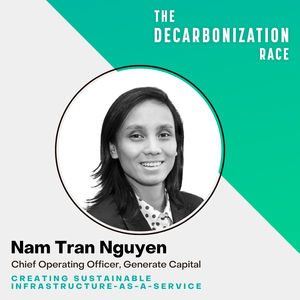
The Decarbonization Race
Lincoln Payton
REPLAY: Creating Sustainable Infrastructure-as-a-Service with Generate Capital's Nam Nguyen

REPLAY: Creating Sustainable Infrastructure-as-a-Service with Generate Capital's Nam Nguyen
Description
Investing in infrastructure is different and more complex than many other investment classes, often involving significantly longer timeframes and larger capital expenditures. Investing in sustainable infrastructure — like renewable energy, energy storage, or electric vehicle fleets — can be attractive to investors but adds complexity and often requires delivering with newer technologies.
Generate Capital was founded in 2014 with an unusual approach: invest, operate and maintain a range of sustainable infrastructure assets for the long term — creating "sustainable infrastructure as a service" — that can provide extended value to investors and customers while yielding lasting environmental, social, and economic benefits.
Nam Nguyen, Chief Operating Officer of Generate Capital and a visionary leader in the clean energy sector, joins Lincoln on the podcast to talk about how she and Generate Capital's team are creating long-term impacts with strategic investments in the sustainable energy, e-mobility, waste and smart cities sectors.
Key Takeaways:
-
When Generate examines an investment opportunity, they view it through the lens of a long-term asset owner, looking at impacts and returns across 20, 30, or 40 years. Therefore, when looking at the opportunities, they are also looking for drivers that are going to factor in for the long term. In addition, they are looking at how to optimize assets and facilities so that they are lasting for a long time.
-
Generate's investment strategy isn't limited to clean energy. Part of their portfolio is a platform called Generate Upcycle, which is focused on the circular economy—keeping waste streams out of landfills, and turning that waste into something more renewable, whether it's in the form of renewable electricity, renewable natural gas, compost or other uses.
-
Generate's team has a problem-solving mindset, because markets change quickly and the world is always evolving. Because of this, Generate's team look at issues, like grid instability in California, and regularly sit down with the company's partners to ask, "how do we solve for this? How do we change the way we utilize the assets we've built to address fresh concerns? How do we optimize portfolios in different parts of our customer base?"